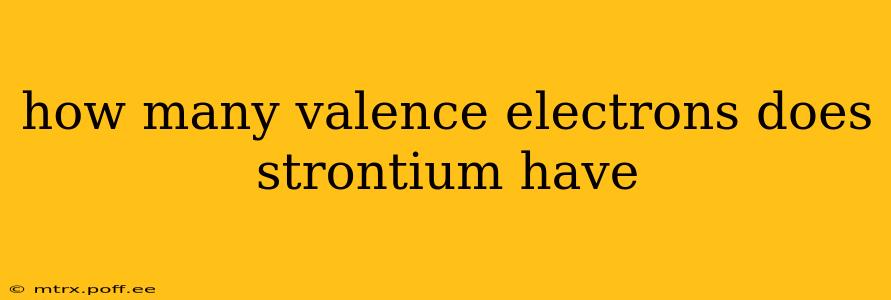Strontium (Sr), an alkaline earth metal, is a fascinating element with key characteristics that determine its reactivity and place in the periodic table. One of the most fundamental properties of any element is its number of valence electrons – those electrons residing in the outermost shell and primarily responsible for chemical bonding. So, how many valence electrons does strontium possess? The answer is two.
This seemingly simple number holds significant implications for strontium's behavior and its role in various applications. Let's delve deeper into the reasons behind this and explore related concepts.
Understanding Valence Electrons
Before we explore strontium specifically, it's crucial to understand the concept of valence electrons. These are the electrons located in the outermost electron shell of an atom. They are the electrons most likely to participate in chemical reactions, forming bonds with other atoms. The number of valence electrons largely dictates an element's chemical properties and reactivity. For example, elements with one or two valence electrons tend to be highly reactive metals, readily losing those electrons to achieve a stable electron configuration.
Strontium's Electronic Configuration and Valence Electrons
Strontium's atomic number is 38, meaning it has 38 protons and 38 electrons in a neutral atom. Its electronic configuration is [Kr]5s². This configuration tells us that strontium has a full inner shell configuration mirroring krypton ([Kr]) and two electrons in its outermost 5s subshell. These two electrons in the 5s subshell are strontium's valence electrons.
Because strontium has two valence electrons, it readily loses them to form a +2 ion (Sr²⁺), achieving a stable electron configuration similar to the noble gas krypton. This tendency to lose electrons is characteristic of metals, particularly alkaline earth metals.
Why is the Number of Valence Electrons Important?
The number of valence electrons is crucial because it:
- Determines reactivity: Elements with fewer valence electrons tend to be more reactive than those with nearly full outer shells.
- Predicts bonding behavior: The number of valence electrons influences the types of chemical bonds an element can form (ionic, covalent, metallic).
- Explains chemical properties: The number of valence electrons largely explains why elements in the same group (column) of the periodic table exhibit similar chemical behavior.
Frequently Asked Questions (FAQs)
What is the oxidation state of strontium?
Strontium's most common oxidation state is +2, due to its two valence electrons. It readily loses these electrons to achieve a stable electron configuration.
How does strontium's valence electron count relate to its position in the periodic table?
Strontium belongs to Group 2 (alkaline earth metals) of the periodic table. All elements in Group 2 have two valence electrons, explaining their similar chemical properties.
What are some common applications of strontium?
Strontium compounds are used in various applications, including:
- Pyrotechnics: Strontium carbonate produces a bright red color in fireworks.
- Specialty glass: Strontium oxide improves the properties of some types of glass.
- Medical applications: Certain strontium isotopes have medical uses, such as in bone scans.
Understanding the number of valence electrons in strontium—and in other elements—provides a fundamental understanding of their chemical behavior and their place within the wider context of the periodic table. This knowledge is essential across various scientific disciplines, from chemistry and materials science to medicine and environmental science.
